(EDITOR’S NOTE: This is one in a series of winter danger articles.)
The cold weather does little to keep winter sports enthusiasts inside – especially children. In fact, children ages 14 and under are at a high risk for winter sports injuries.
It’s an age-old tradition for kids to get out and play in snow that their parents work hard to avoid.
Unfortunately, it’s also traditional for some of those kids to get hurt in the process, and according to
the United States Consumer Product Safety Commission, special equipment is important for some winter outdoor activities.
Safe Kids Kansas is urging parents to follow up on the national effort to keep kids safe, and that includes them wearing helmets if they ski or snowboard.
This isn’t about just a few instances, either. “In 2007, there were 17,000 estimated injuries among children from skiing and snowboarding; 24,500 estimated injuries from sledding; and 1,500 estimated injuries from snowmobiles and other equipment,” according to the Safe Kids Kansas information.
Along with wearing a helmet while skiing or snowboarding, parents should know these ten useful tips to keep their children safe when doing outdoor activities this winter:
Sledding
Other winter safety tips include:
• Kids can suffer serious head injuries from sledding and should wear a helmet. When sledding, do not go down a hill head-first. Sit up, face forward, use a clear, safe path (free of trees, rocks and bare spots) and make sure an adult is supervising.
• A good sledding hill does not lead to a street, a body of water, a fence (including barbed wire) or a crowded gathering place. In addition, remember to inspect sleds regularly for worn, damaged or loose parts that could break or snag at high speed.
• Never tether a sled to a moving vehicle. The results can be deadly.
Snowmobiles
• Children under 6 should not be riding a snowmobile and no one under 16 should drive one. All snowmobile drivers and passengers should be wearing helmets designed for high-speed motor sports - a bike helmet isn’t sufficient for a four-wheeled motorcycle that can go up to 90 miles per hour.
• Dress in layers and wear warm, close-fitting clothes. Make sure that long scarves are tucked in so they don’t get entangled.
• Stay hydrated and wear sunscreen with a rating of SPF 15 or higher.
• If children become distracted, irritable, or begin to hyperventilate, they may be suffering from hypothermia, or are too tired to participate safely in winter sports. They should go indoors, rest and warm up.
While playing in snow is a lot of fun, safety experts in this part of the state warn that our local ice never gets safe. It’s a bad idea for kids to play on any pond or sandpit ice, they warn.
Winter poses special dangers for children





